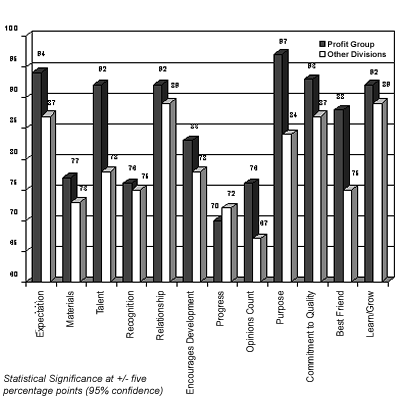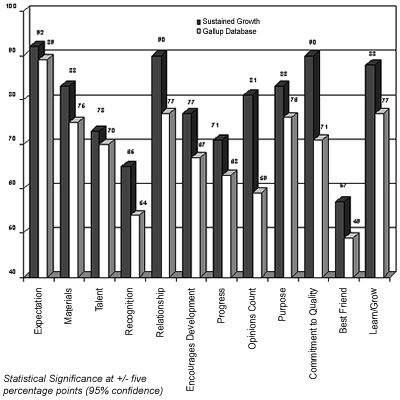|
Leading versus Trailing Indicators
Organizations traditionally have relied heavily upon financial
measures or "hard" numbers to evaluate their performance,
value and "health." However, such metrics as profitability,
revenues, return on capital, cash flow and various margins are inadequate
for developing strategies and implementation plans for the future.
Proactive leaders have come to rely more and more upon the "soft"
numbers to best predict direction and action planning. These numbers
tend to be metrics related to Brand, Customer Loyalty Development,
and Employee Engagement. Our research confirms the strong linkages
among organizational effectiveness, customer loyalty, brand loyalty
and important business outcomes. As this article will argue, it
is more effective for business leaders to examine the "soft"
numbers for direction as to the steps they should take to drive
sales and profits.
|
Financial
Business Metrics
|
 |
Trailing
Indicators |
|
|
|
|
|
|
|
Brand
Loyalty
|
Growing
Loyal
Customers
|
Employees
|
 |
Leading
Indicators |
Employee Engagement as a Leading Indicator
This document is intended to focus upon Employee Engagement as
a leading indicator and correlate with other more tangible business
outcomes.
Traditionally, there have been two problems with the research on
employee attitudes and perceptions. First, the purpose or reason
for the measurement is usually not well defined, and the relationship
between employee attitudes and business outcomes has never been
clearly established. Second, employee measurement has usually been
seen not as a tool to create understanding and communication, but
rather as a device to better "control" employees, managers
and the work environment. If the workplace and the perceptions of
employees can indeed create a competitive advantage for an organization,
then we must begin to approach employee measurement with valid linkages
to the outcomes that are derived.
The Gallup Organization has interviewed over one million employees
worldwide. Analysis of the employee attitude responses across companies
and cultures demonstrates that 12 key areas consistently relate
to Retention of Employees, Business Unit Productivity, Profitability,
and Customer Loyalty. These 12 areas have been distilled into statements
that are used with employees to understand the existence within
one's own company. These statements are listed below:
|
The Gallup Q12 - The 12 Gallup Workplace Audit Statements:
- I know what is expected of me at work
- I have the materials and equipment I need to do my
work right
- At work, I have the opportunity to do what I do best
every day
- In the last seven days, I have received recognition
or praise for doing good work
- My supervisor or someone at work seems to care about
me as a person
- There is someone at work who encourages my development
- At work, my opinions seem to count
- The mission/purpose of my company makes me feel my
job is important
- My associates (fellow employees) are committed to doing
quality work
- I have a best friend at work
- In the last six months, someone at work has talked
to me about my progress
- This last year, I have had opportunities at work to
learn and grow
All statements ©1997-1999 The Gallup
Organization. Reproduction and usage restrictions apply.
|
Validation
If these "softer" or less tangible employee perceptions
are to be taken seriously, one must validate each of the 12's relationship
to "harder" outcomes. Validity is established in many
ways. One is content validity, which is the degree to which the
hypothesis aligns with common sense and current understanding. Gallup
has historically found, and continues to find, through hundreds
of focus groups with top- performing employees and managers at all
levels, that these 12 statements make sense and are true issues
facing people every day. Another validity test is criterion-related
validity, which tests the existence of the 12 conditions in situations
in which specific business outcomes are in evidence. It then compares
their existence where business outcomes are less present. An example
would involve taking the ten most profitable divisions, and look
at how those divisions responded to the 12 items versus the remainder
of the company divisions. Gallup has studied, in a variety of businesses
and industries, the statistical relationship between employee perceptions
and workplace outcomes. This combined evidence, or meta-analysis,
forms a very strong basis for determining the true patterns present
in most work environments.
Gallup has rigorously researched workplace perceptions in defining
the validity of 12 core perceptions that relate to meaningful business
outcomes-both conceptually and statistically.
Profitable Divisions-Are They Different?
Gallup examined an organization and isolated the specific divisions
that demonstrated sustained profitability over a ten-year period.
This group of divisions was identified as the "profit group."
Personnel within these divisions were asked the 12 questions and
their responses were then compared to the employee responses in
the remaining divisions.

Figure 1 Profitable Divisions - Are They Different?
Figure 1 illustrates the difference in the percentage of favorable
responses for divisions with sustained profitability versus other
divisions of the company. For Company A, the differences were
greatest on talent-At work, I have the opportunity to do what
I do best every day, purpose-The mission/purpose of my company
makes me feel my job is important, and best friend-I have a best
friend at work. In thinking about success within Company A, it
is clear that the most consistently profitable divisions have
people doing what they like to do, with people they like, with
a strong sense of psychological ownership for the outcome of their
work. Their work is not "just a job," they see how it
relates to other important outcomes. The growth opportunity for
Company A probably involves studying what is going on in its most
successful division, that is-what behaviors lead to these perceptions,
and then replicating those behaviors in other divisions.
Growth Oriented/Performing Companies-Are they Different?
As a general test for Criterion-Related Validity, Gallup examined
15 fast-growing companies that have shown sustained profitability
and revenue growth. A census sample (86% response rate) of these
15 companies' employees was surveyed and results were then compared
to results for other companies within the Gallup comparative database.

Figure 2 Growth Oriented/Performing Companies
- Are They Different?
As is evident in Figure 2, sustained growth organizations had
more positive employee perceptions on all 12 workplace statements.
Largest differences were on opinions count—At work,
my opinions seem to count, and commitment to quality—My
associates are committed to doing quality work. Organizations
with sustained growth have an extremely high percentage of employees
who are committed to quality, and these employees do a good job
of listening to one another. Other differences of 10 percentage
points were; relationship, opportunities to learn and grow,
and encourages development. The above may be key descriptors
of sustained growth environments. Clarifying expectations may
be a given, whereas relationship, fulfillment, and rewards
may be a competitive advantage.
Empirical Validity
Meta Analysis
Another form of validation is that of empirical review. For this,
Gallup combined its research studying the relationship between
workplace perceptions and business outcomes across 2500 business,
healthcare, and education units.
The following 12 industries were represented:
- Healthcare
- Restaurant
- Education
- Retail
|
- Entertainment
- Grocery
- Research
- Hospitality
|
- Telecommunications
- Medical Sales
- Financial
- Electronics
|
The following four general outcomes were studied:
- Productivity
- Employee Turnover
|
- Profitability
- Customer Satisfaction
|
The meta-analysis was completed to review correlations between
each of the 12 items and business outcomes. The results confirmed
previous hypotheses. Each of the twelve questions relate to meaningful
business outcomes. The following table presents a review of the
strongest patterns across organizations:
| Question |
Productivity |
Turnover |
Profit
|
Customer |
| Q1.
Expected |
X
|
X
|
X
|
X
|
| Q2.
Mat. & Equipment |
X
|
X
|
|
|
| Q3.
Opportunity |
|
X
|
X
|
X
|
| Q4.
Recognition |
X
|
|
X
|
X
|
| Q5.
Cares |
X
|
X
|
X
|
X
|
| Q6.
Development |
X
|
|
X
|
|
| Q7.
Opinions |
X
|
|
X
|
|
| Q8.
Mission |
X
|
|
|
|
| Q9.
Comm. To Quality |
X
|
|
X
|
|
| Q10.
Best Friend |
X
|
|
|
X
|
| Q11.
Progress |
X
|
|
|
X
|
| Q12.
Learn & Grow |
|
|
X
|
|
| Overall
Satisfaction |
X
|
X
|
X
|
|
X = Strongest positive correlations; higher
scores associated with higher outcomes, and generalizable across
the organizations we've studied.
Here are a few examples of what the above relationships mean
to organizations we've studied.
Productivity:
Business units in the top quartile of the Grandmean of the 12
items have a 50% higher success rate in comparison to business
units in the bottom quartile.
Employee Turnover:
Business units in the top quartile of the Grandmean of the 12
items have a 13% higher success rate (less turnover) in comparison
to business units in the bottom quartile.
Profit:
Business units in the top quartile of the Grandmean of the12 items
have a 44% higher success rate in comparison to business units
in the bottom quartile.
Customer Satisfaction:
Business units in the top quartile of the Grandmean of the 12
items have a 50% higher success rate in comparison to business
units in the bottom quartile.
* success rate is defined as above average performance for
business units within a given company
Conclusions
The Gallup Organization has studied a wide variety of organizations
and production/service units within those organizations. Our research
over the years, both qualitative and quantitative, has isolated
the key dimensions that consistently differentiate very successful
business units from less successful business units. Gallup's research
has also isolated the specific question items that appear to best
measure those dimensions. Successful companies and, even more
specifically, successful business units within any company, have
different profiles of employee perceptions than less successful
organizations and business units. The data clearly show that within
successful business units employees have clear expectations, close
relationships, can see how what they do relates to "something
significant," and have an ongoing opportunity to contribute
to that "something significant" while learning and growing
as individuals. Further, the behaviors that help to define these
seemingly intangible perceptions can be discovered by studying
the success within one's own organization.
|


